Data-Driven Design of Nickel-Free Superelastic Titanium Alloys
Abstract
1. Introduction
2. Materials and Methods
2.1. Dataset Establishment
2.2. Feature Construction
2.3. Feature Selection
2.4. Machine Learning
2.5. Experimental Validation
3. Results
3.1. Feature Selection and Model Establishment
3.2. New Alloy Design
- 0 ≤ Nb ≤ 25 at.%,
- 0 ≤ Mo ≤ 5 at.%,
- 0 ≤ Zr ≤ 30 at.%,
- 0 ≤ Sn ≤ 5 at.%,
- 0 ≤ Ta ≤ 5 at.%,
- Nb + Mo + Zr + Sn + Ta + Ti = 100 at.%,
- Zr < Ti,
- strain = 0.985
- T1 = 1173 K,
- t1 = 30 min.
3.3. Feature Analysis
3.4. Experimental Validation
4. Conclusions
- Machine learning models were established based on 125 data points. Among them, the CatBoost model constructed with features strain, T1, t1, E, MP3 and PE4 performed the best with an R2 of 0.83 and MAE of 0.44.
- The features included in the final feature set, such as strain, T1, and t1 were mainly related to the processing and preparation of the alloy. The reason higher cold rolling deformation and annealing temperature were advantageous for the superelastic performance of the alloy was that high-temperature annealing after large-deformation cold rolling facilitates the formation of fine grains and strong texture.
- Three alloy compositions including Ti-11Nb-26Zr-2Sn, Ti-12Nb-18Zr-2Sn and Ti-12Nb-16Zr-3Sn were designed using a Bayesian optimization algorithm which could quickly perform alloy composition optimization. After 60 iterations, it searched for alloy compositions with a superelastic strain greater than 6%.
- Due to the lack of assessment of β stability in the model, only the Ti-12Nb-18Zr-2Sn and Ti-12Nb-16Zr-3Sn alloys exhibited a superelastic performance. The superelastic performance of both alloys matched the predictions of machine learning based on actual processes. After thermal treatment process optimization, they exhibited a recovery strain of 4.65% and 3.01%, respectively.
Author Contributions
Funding
Institutional Review Board Statement
Informed Consent Statement
Data Availability Statement
Conflicts of Interest
References
- Fadlallah, S.A.; El-Bagoury, N.; El-Rab, S.M.G.; Ahmed, R.A.; El-Ousamii, G. An overview of NiTi shape memory alloy: Corrosion resistance and antibacterial inhibition for dental application. J. Alloys Compd. 2014, 583, 455–464. [Google Scholar] [CrossRef]
- Patel, S.K.; Behera, B.; Swain, B.; Roshan, R.; Sahoo, D.; Behera, A. A review on NiTi alloys for biomedical applications and their biocompatibility. Mater. Today Proc. 2020, 33, 5548–5551. [Google Scholar] [CrossRef]
- Duerig, T.W.; Melton, K.; Stöckel, D. Engineering Aspects of Shape Memory Alloys; Butterworth-Heinemann: Oxford, UK, 2013. [Google Scholar]
- Jani, J.M.; Leary, M.; Subic, A.; Gibson, M.A. A review of shape memory alloy research, applications and opportunities. Mater. Des. (1980–2015) 2014, 56, 1078–1113. [Google Scholar] [CrossRef]
- Biesiekierski, A.; Wang, J.; Gepreel, M.A.-H.; Wen, C. A new look at biomedical Ti-based shape memory alloys. Acta Biomater. 2012, 8, 1661–1669. [Google Scholar] [CrossRef] [PubMed]
- Ramezannejad, A.; Xu, W.; Xiao, W.; Fox, K.; Liang, D.; Qian, M. New insights into nickel-free superelastic titanium alloys for biomedical applications. Curr. Opin. Solid State Mater. Sci. 2019, 23, 100783. [Google Scholar] [CrossRef]
- Kim, H.; Ikehara, Y.; Kim, J.I.; Hosoda, H.; Miyazaki, S. Martensitic transformation, shape memory effect and superelasticity of Ti–Nb binary alloys. Acta Mater. 2006, 54, 2419–2429. [Google Scholar] [CrossRef]
- Buenconsejo, P.J.S.; Kim, H.Y.; Hosoda, H.; Miyazaki, S. Shape memory behavior of Ti–Ta and its potential as a high-temperature shape memory alloy. Acta Mater. 2009, 57, 1068–1077. [Google Scholar] [CrossRef]
- Kim, H.Y.; Hashimoto, S.; Kim, J.I.; Hosoda, H.; Miyazaki, S. Mechanical properties and shape memory behavior of Ti-Nb alloys. Mater. Trans. 2004, 45, 2443–2448. [Google Scholar] [CrossRef]
- Kim, K.M.; Kim, H.Y.; Miyazaki, S. Effect of Zr content on phase stability, deformation behavior, and Young’s modulus in Ti–Nb–Zr alloys. Materials 2020, 13, 476. [Google Scholar] [CrossRef]
- Al-Zain, Y.; Kim, H.; Hosoda, H.; Nam, T.; Miyazaki, S. Shape memory properties of Ti–Nb–Mo biomedical alloys. Acta Mater. 2010, 58, 4212–4223. [Google Scholar] [CrossRef]
- Kim, J.I.; Kim, H.; Inamura, T.; Hosoda, H.; Miyazaki, S. Shape memory characteristics of Ti–22Nb–(2–8) Zr (at.%) biomedical alloys. Mater. Sci. Eng. A 2005, 403, 334–339. [Google Scholar] [CrossRef]
- Endoh, K.; Tahara, M.; Inamura, T.; Hosoda, H. Effect of Sn and Zr addition on the martensitic transformation behavior of Ti-Mo shape memory alloys. J. Alloys Compd. 2017, 695, 76–82. [Google Scholar] [CrossRef]
- Kim, H.; Hashimoto, S.; Kim, J.; Inamura, T.; Hosoda, H.; Miyazaki, S. Effect of Ta addition on shape memory behavior of Ti–22Nb alloy. Mater. Sci. Eng. A 2006, 417, 120–128. [Google Scholar] [CrossRef]
- Li, S.; Choi, M.-S.; Nam, T.-H. Role of fine nano-scaled isothermal omega phase on the mechanical and superelastic properties of a high Zr-containing Ti–Zr–Nb–Sn shape memory alloy. Mater. Sci. Eng. A 2020, 782, 139278. [Google Scholar] [CrossRef]
- Sun, F.; Nowak, S.; Gloriant, T.; Laheurte, P.; Eberhardt, A.; Prima, F. Influence of a short thermal treatment on the superelastic properties of a titanium-based alloy. Scr. Mater. 2010, 63, 1053–1056. [Google Scholar] [CrossRef]
- Mueller, T.; Kusne, A.G.; Ramprasad, R. Machine learning in materials science: Recent progress and emerging applications. Rev. Comput. Chem. 2016, 29, 186–273. [Google Scholar] [CrossRef]
- Morgan, D.; Jacobs, R. Opportunities and challenges for machine learning in materials science. Annu. Rev. Mater. Res. 2020, 50, 71–103. [Google Scholar] [CrossRef]
- Hart, G.L.; Mueller, T.; Toher, C.; Curtarolo, S. Machine learning for alloys. Nat. Rev. Mater. 2021, 6, 730–755. [Google Scholar] [CrossRef]
- Xue, D.; Xue, D.; Yuan, R.; Zhou, Y.; Balachandran, P.V.; Ding, X.; Sun, J.; Lookman, T. An informatics approach to transformation temperatures of NiTi-based shape memory alloys. Acta Mater. 2017, 125, 532–541. [Google Scholar] [CrossRef]
- Xue, D.; Balachandran, P.V.; Hogden, J.; Theiler, J.; Xue, D.; Lookman, T. Accelerated search for materials with targeted properties by adaptive design. Nat. Commun. 2016, 7, 11241. [Google Scholar] [CrossRef]
- Wang, L.; Fu, C.; Wu, Y.; Li, R.; Wang, Y.; Hui, X. Ductile Ti-rich high-entropy alloy controlled by stress induced martensitic transformation and mechanical twinning. Mater. Sci. Eng. A 2019, 763, 138147. [Google Scholar] [CrossRef]
- Niinomi, M. Recent research and development in titanium alloys for biomedical applications and healthcare goods. Sci. Technol. Adv. Mater. 2003, 4, 445. [Google Scholar] [CrossRef]
- Kolli, R.P.; Devaraj, A. A review of metastable beta titanium alloys. Metals 2018, 8, 506. [Google Scholar] [CrossRef]
- Bahl, S.; Suwas, S.; Chatterjee, K. Comprehensive review on alloy design, processing, and performance of β Titanium alloys as biomedical materials. Int. Mater. Rev. 2021, 66, 114–139. [Google Scholar] [CrossRef]
- Sidhu, S.S.; Singh, H.; Gepreel, M.A.-H. A review on alloy design, biological response, and strengthening of β-titanium alloys as biomaterials. Mater. Sci. Eng. C 2021, 121, 111661. [Google Scholar] [CrossRef]
- Carruthers, C.; Teitelbaum, H. The linear mixture rule in chemical kinetics. II. Thermal dissociation of diatomic molecules. Chem. Phys. 1988, 127, 351–362. [Google Scholar] [CrossRef]
- Mckee, R.H.; Medeiros, A.M.; Daughtrey, W.C. A proposed methodology for setting occupational exposure limits for hydrocarbon solvents. J. Occup. Environ. Hyg. 2005, 2, 524–542. [Google Scholar] [CrossRef]
- Xiong, J.; Shi, S.-Q.; Zhang, T.-Y. A machine-learning approach to predicting and understanding the properties of amorphous metallic alloys. Mater. Des. 2020, 187, 108378. [Google Scholar] [CrossRef]
- Cai, J.; Luo, J.; Wang, S.; Yang, S. Feature selection in machine learning: A new perspective. Neurocomputing 2018, 300, 70–79. [Google Scholar] [CrossRef]
- Li, H.; Li, X.; Li, Y.; Xiao, W.; Wen, K.; Li, Z.; Zhang, Y.; Xiong, B. Machine learning assisted design of aluminum-lithium alloy with high specific modulus and specific strength. Mater. Des. 2023, 225, 111483. [Google Scholar] [CrossRef]
- Li, S.; Kim, Y.-W.; Choi, M.-S.; Kim, J.G.; Nam, T.-H. Superelasticity, microstructure and texture characteristics of the rapidly solidified Ti–Zr–Nb–Sn shape memory alloy fibers for biomedical applications. Mater. Sci. Eng. A 2022, 831, 142001. [Google Scholar] [CrossRef]
- Wadood, A.; Inamura, T.; Yamabe-Mitarai, Y.; Hosoda, H. Effect of uniform distribution of α phase on mechanical, shape memory and pseudoelastic properties of Ti–6Cr–3Sn alloy. Mater. Sci. Eng. A 2012, 555, 28–35. [Google Scholar] [CrossRef]
- Zhang, H.; Fu, H.; He, X.; Wang, C.; Jiang, L.; Chen, L.-Q.; Xie, J. Dramatically enhanced combination of ultimate tensile strength and electric conductivity of alloys via machine learning screening. Acta Mater. 2020, 200, 803–810. [Google Scholar] [CrossRef]
- Pavón, L.L.; Kim, H.Y.; Hosoda, H.; Miyazaki, S. Effect of Nb content and heat treatment temperature on superelastic properties of Ti–24Zr–(8–12) Nb–2Sn alloys. Scr. Mater. 2015, 95, 46–49. [Google Scholar] [CrossRef]
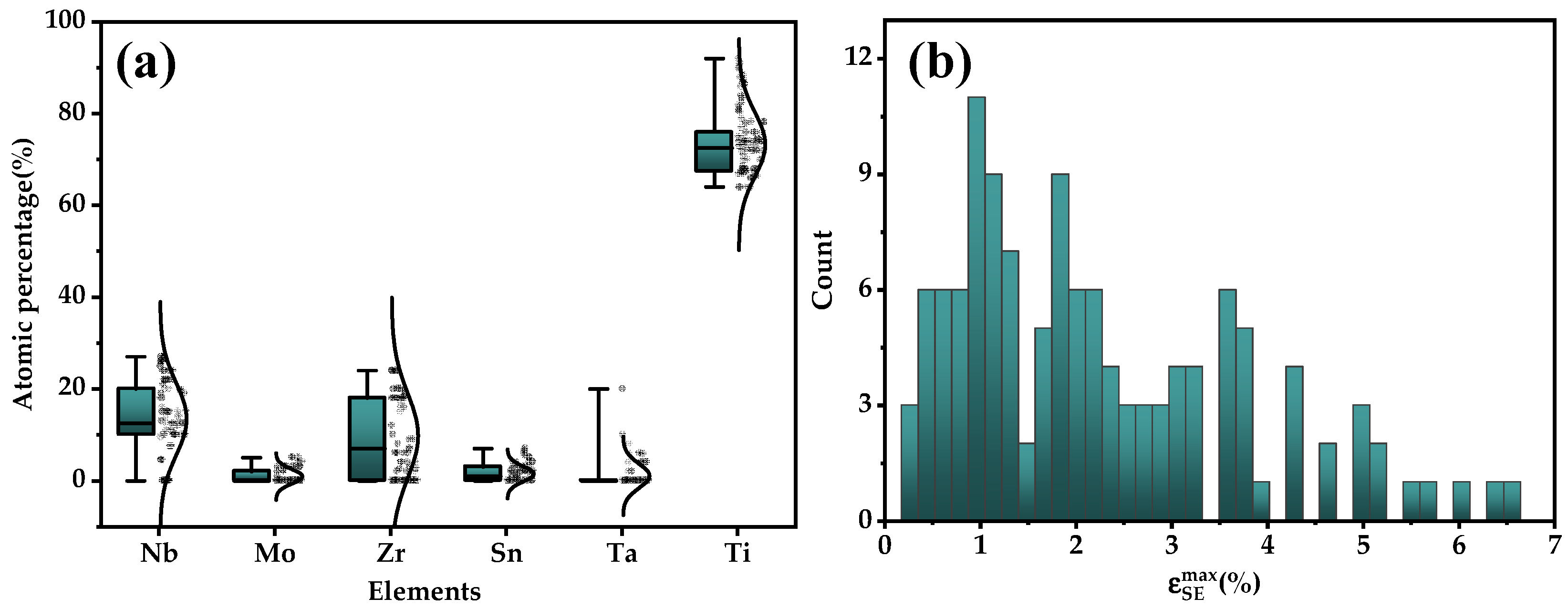
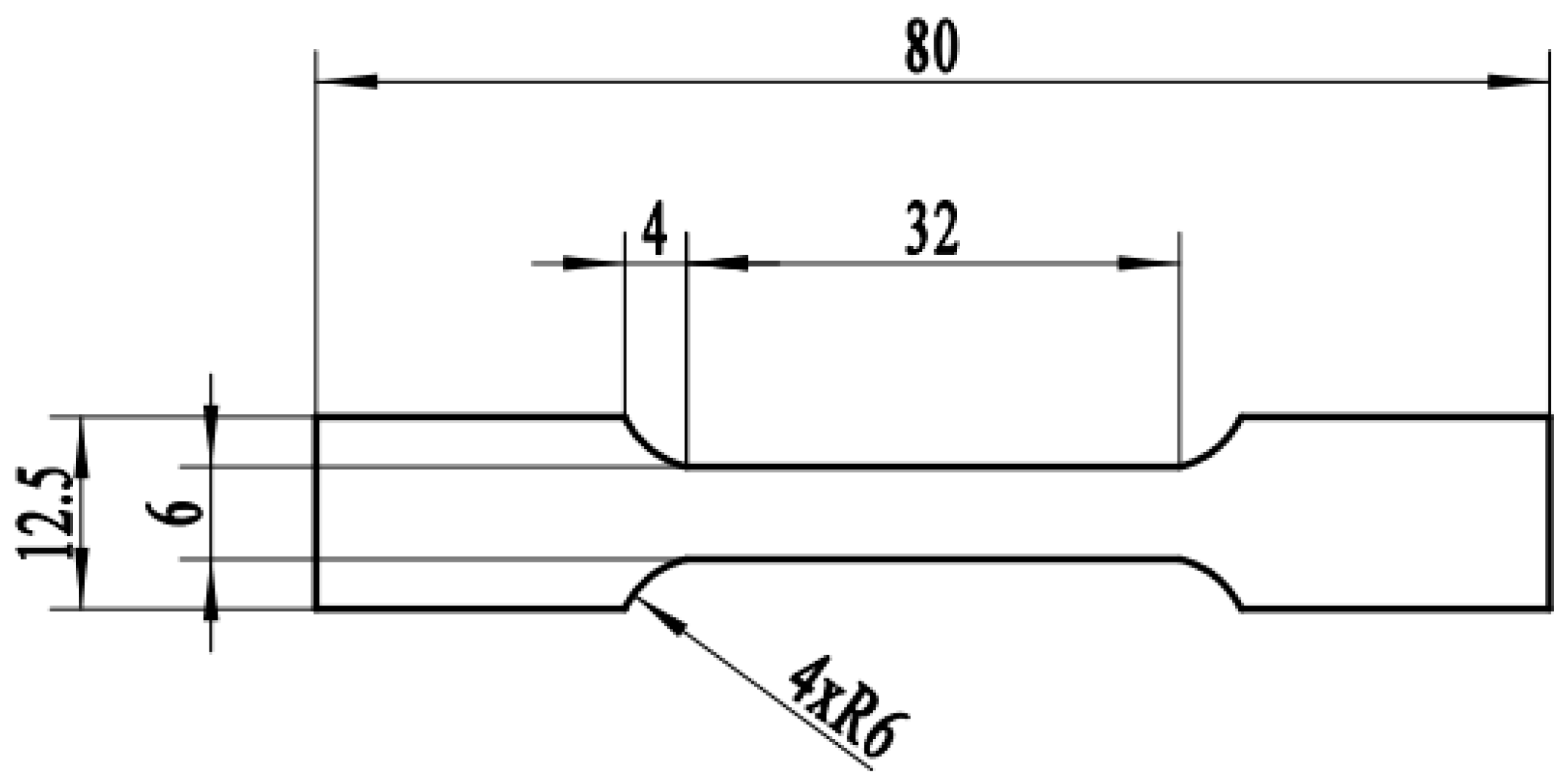

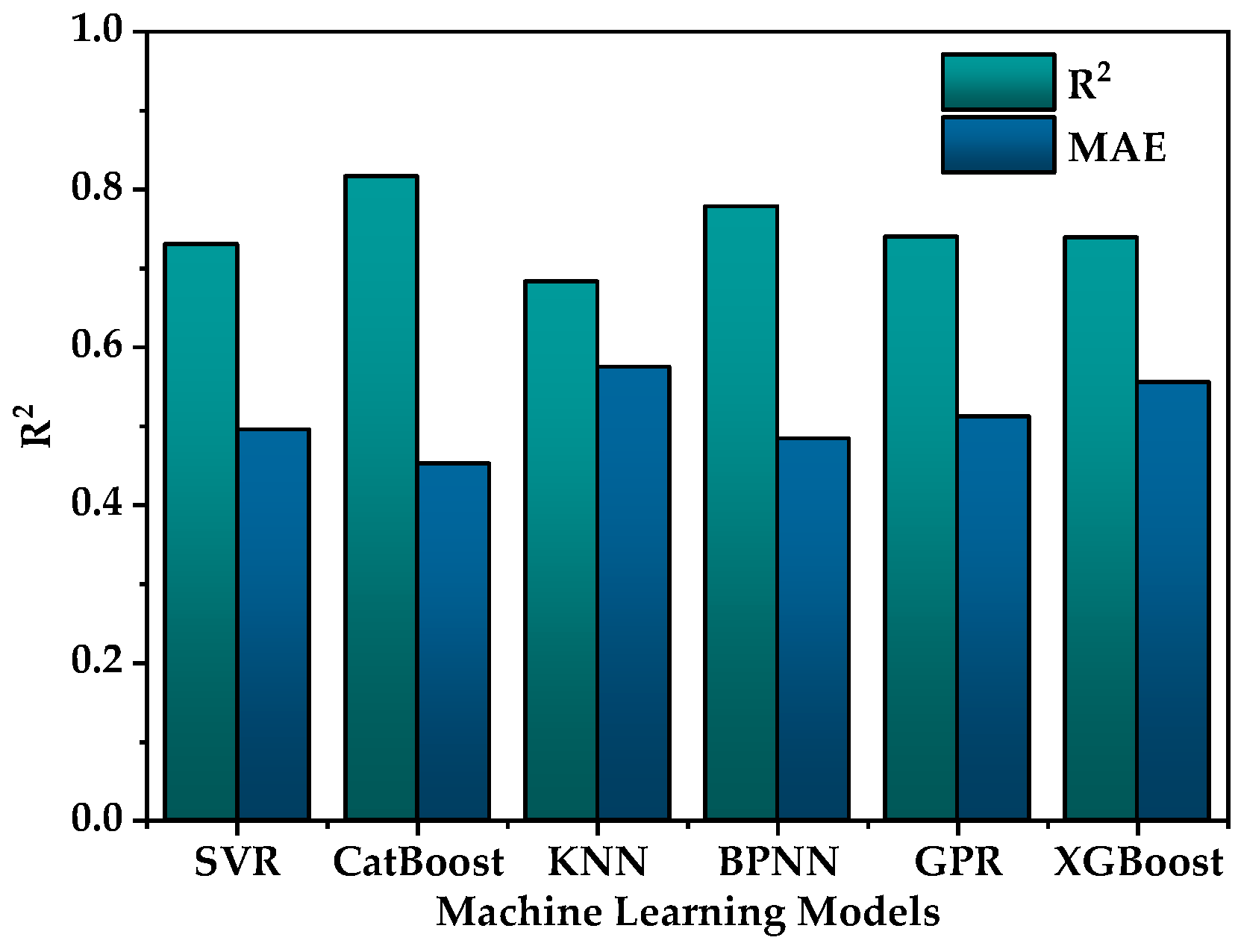
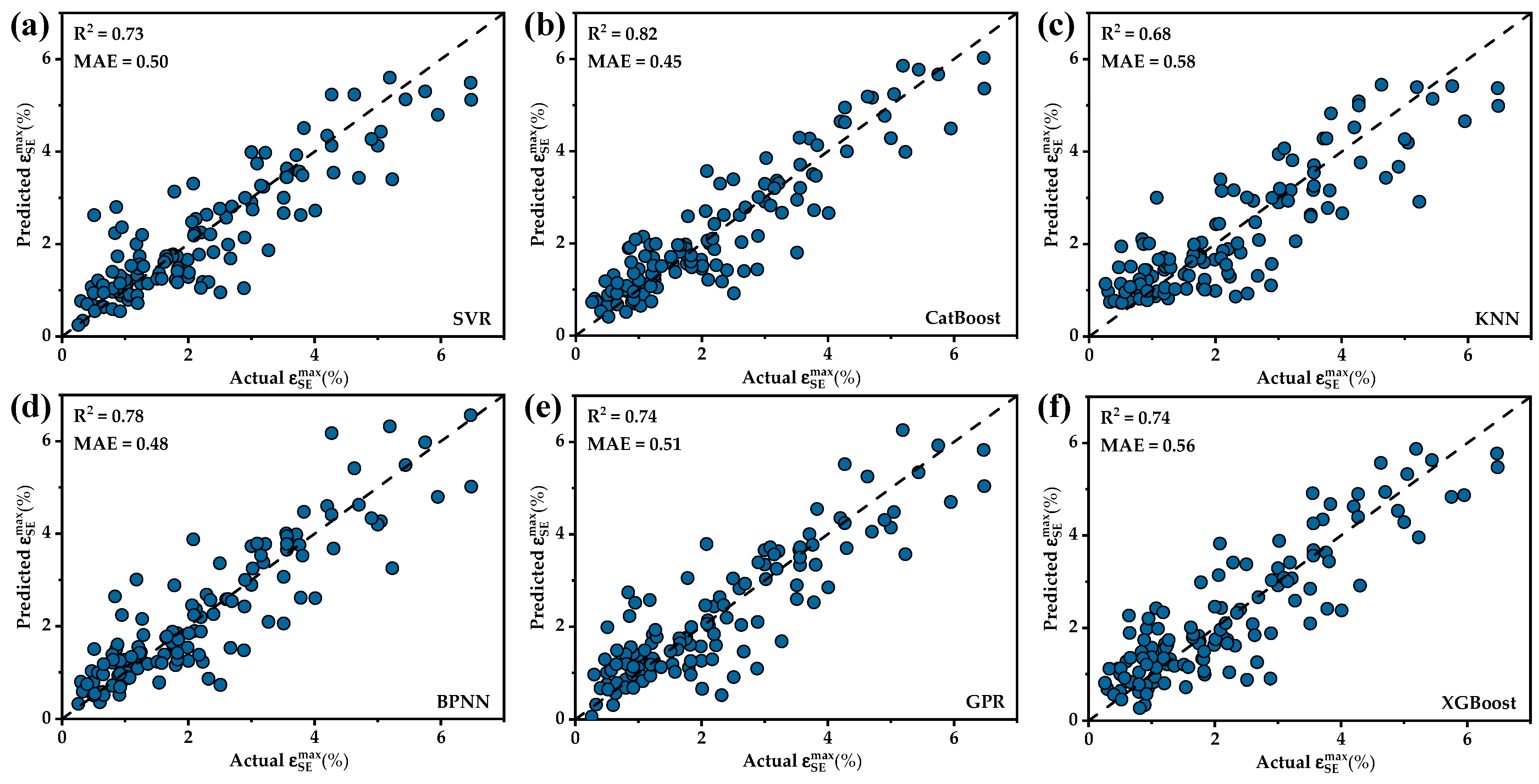





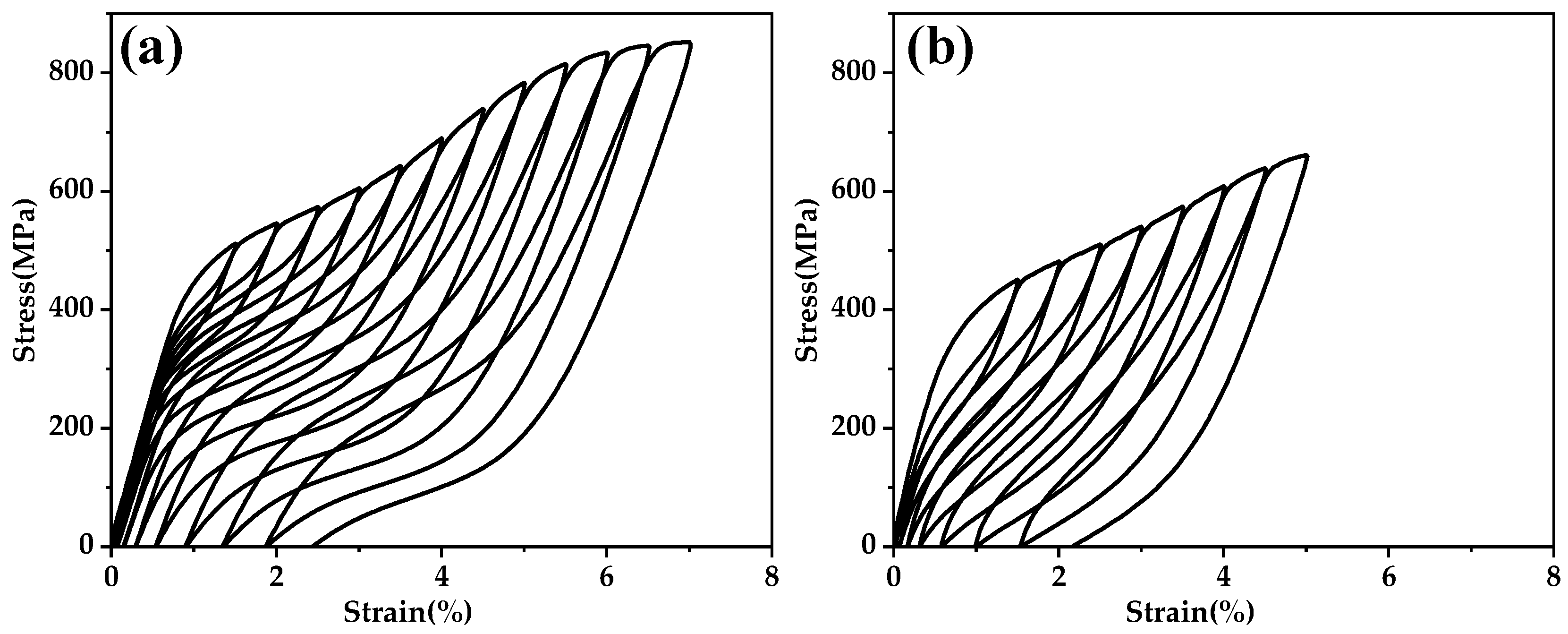
| Classification | Description | Symbol |
|---|---|---|
| Processing process | Cold rolling reduction | strain |
| Annealing temperature | T1 | |
| Annealing time | t1 | |
| Empirical parameters of alloy design | Mo equivalent | Moeq |
| Bo | Bo | |
| Md | Md | |
| Valence electron concentration | VEC | |
| Phase formation parameters | Enthalpy of mixing | ΔHmix |
| Entropy of mixing | ΔSmix | |
| Solid solution phase formation parameter | Ω | |
| Element features | Atomic number | NA |
| Atomic mass | MA | |
| Density | ρ | |
| Period | P | |
| Group | G | |
| Atomic radius | RA | |
| Covalent radius | RC | |
| Lattice constant | a | |
| Lattice constant | c | |
| Physical and chemical features | Young’s modulus | E |
| Melting point | MP | |
| Boiling point | BP | |
| Resistance | R | |
| Thermal conductivity | TC | |
| Thermal expansion coefficient | Cte | |
| Pauling electronegativity | PE | |
| Heat of fusion | Hf |
| Models | Hyperparameters |
|---|---|
| SVR | C: 4.87, gamma: 2.03, epsilon: 4.38 × 10−4 |
| CatBoost | iterations: 399, learning_rate: 0.23, l2_leaf_reg: 1.90, depth:6, subsample: 0.45, rsm: 0.95 |
| KNN | n_neighbors: 6, weights: distance, algorithm: kd_tree |
| BPNN | n_layers: 2, n_units_l0: 88, n_units_l1: 40, alpha: 0.60, learning_rate_init: 0.002, momentum: 0.60, max_iter: 5000 |
| GPR | alpha: 0.01 |
| XGBoost | lambda: 136.32, alpha: 0.02, learning_rate: 1.49, n_estimators: 1017, max_depth: 120, gamma: 0.0003, min_child_weight: 1 |
| Alloys | Nb | Zr | Sn | Ti |
|---|---|---|---|---|
| Ⅰ | 11 | 26 | 2 | 61 |
| Ⅱ | 12 | 18 | 2 | 68 |
| Ⅲ | 12 | 16 | 3 | 69 |
| Alloys | Nb | Zr | Sn | Ti |
|---|---|---|---|---|
| Ⅰ | 10.72 | 26.51 | 2.00 | 60.77 |
| Ⅱ | 12.28 | 17.14 | 2.02 | 68.55 |
| Ⅱ | 11.62 | 15.89 | 3.12 | 69.37 |
Disclaimer/Publisher’s Note: The statements, opinions and data contained in all publications are solely those of the individual author(s) and contributor(s) and not of MDPI and/or the editor(s). MDPI and/or the editor(s) disclaim responsibility for any injury to people or property resulting from any ideas, methods, instructions or products referred to in the content. |
© 2024 by the authors. Licensee MDPI, Basel, Switzerland. This article is an open access article distributed under the terms and conditions of the Creative Commons Attribution (CC BY) license (https://creativecommons.org/licenses/by/4.0/).
Share and Cite
Chen, H.; Ye, W.; Hui, S.; Yu, Y. Data-Driven Design of Nickel-Free Superelastic Titanium Alloys. Materials 2024, 17, 1793. https://doi.org/10.3390/ma17081793
Chen H, Ye W, Hui S, Yu Y. Data-Driven Design of Nickel-Free Superelastic Titanium Alloys. Materials. 2024; 17(8):1793. https://doi.org/10.3390/ma17081793
Chicago/Turabian StyleChen, Haodong, Wenjun Ye, Songxiao Hui, and Yang Yu. 2024. "Data-Driven Design of Nickel-Free Superelastic Titanium Alloys" Materials 17, no. 8: 1793. https://doi.org/10.3390/ma17081793
APA StyleChen, H., Ye, W., Hui, S., & Yu, Y. (2024). Data-Driven Design of Nickel-Free Superelastic Titanium Alloys. Materials, 17(8), 1793. https://doi.org/10.3390/ma17081793





